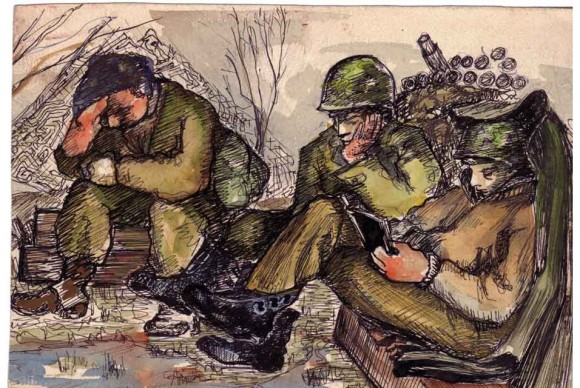New documentary reveals story of WWII unit that duped Hitler’s army – with rubber tanks
May 8, 2013 by All Art News
Filed under Education & Research
NEW YORK, NY.- War, deception and art come together in Rick Beyer’s new documentary The Ghost Army, the astonishing true story of American G.I.s — many of whom would go on to have illustrious careers in art, design and fashion — who tricked the enemy with rubber tanks, sound effects, and carefully crafted illusions during the Second World War. A remarkable story of a top-secret mission that was at once absurd, deadly and amazingly effective, The Ghost Army premieres on Tuesday, May 21, 2013, 8:00-9:00 p.m. ET on PBS (check local listings).
In the summer of 1944, a handpicked group of G.I.s landed in France to conduct a special mission. Armed with truckloads of inflatable tanks, a massive collection of sound effects records, and more than a few tricks up their sleeves, their job was to create a traveling road show of deception on the battlefields of Europe , with the German Army as their audience. From Normandy to the Rhine, the 1100 men of the 23rd Headquarters Special Troops, known as the Ghost Army, conjured up phony convoys, phantom divisions, and make-believe headquarters to fool the enemy about the strength and location of American units. Every move they made was top secret and their story was hushed up for decades after the war’s end.

Weary soldiers: A painting by John Jarvie that captures the exhaustion of his comrades. Many of the Ghost Army soldiers were artists who used stolen moments of spare time to paint and sketch. Photo: John Jarvie.
Each deception required that they impersonate a different (and vastly larger) U.S. unit. Like actors in a repertory theater, they would mount an ever-changing multimedia show tailored to each deception. The men immersed themselves in their roles, even hanging out at local cafes and spinning their counterfeit stories for spies who might lurk in the shadows. Painstakingly recorded sounds of armored and infantry units were blasted from sound trucks; radio operators created phony traffic nets; and inflatable tanks, trucks, artillery and even airplanes were imperfectly camouflaged so they would be visible to enemy reconnaissance. The Ghost Army staged more than 20 deception operations in France , Belgium , Luxembourg and Germany , often operating dangerously close to the front lines. In the final days of the war they faced their ultimate test: a deception along the Rhine in which thousands of lives depended on their delivering a convincing performance. What they accomplished was kept secret for nearly fifty years.
“It’s the highest kind of creativity in the art of war.” – General Wesley Clark (Ret)
Many of the men chosen to carry out these deceptions were young artists recruited from art schools across the country. In their spare time, they painted and sketched their way across Europe , creating a unique and moving visual record of their war. Some would go on to become famous, including fashion designer Bill Blass, painter Ellsworth Kelley and photographer Art Kane.
Interviews with nineteen Ghost Army veterans are the heart of the film. The Ghost Army may be one of the last World War II documentaries told in the words of the men who served. Filmmaker Rick Beyer devoted a major portion of the last eight years to the project, after being introduced to the story in a Lexington , Massachusetts coffee shop. “The niece of a Ghost Army veteran brought me an armload of her uncle’s wartime watercolors and sketches and told me the story. I was hooked,” he says, “and since then I’ve been determined to bring the amazing story of these creative soldiers to the world.”
More than 65 years after the end of the war, the surviving members of the Ghost Army are proud that they used artistry and creativity to save lives. Theirs is not just another war story but a multi-layered tale of showmanship, creativity and humanity.
